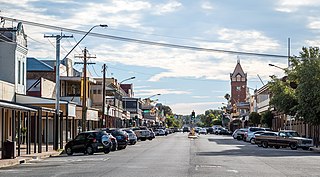
Broken Hill is a city in the far west region of outback New South Wales, Australia. An inland mining city, is near the border with South Australia on the crossing of the Barrier Highway (A32) and the Silver City Highway (B79), in the Barrier Range. It is 315 m (1,033 ft) above sea level, with a cold semi arid climate, and an average rainfall of 265 mm (10.4 in). The closest major city is Mildura, 300 km (190 mi) to the south and the nearest State Capital City is Adelaide, the capital of South Australia, which is more than 500 km (310 mi) to the southwest and linked via route A32.

The Swansea and Mumbles Railway was the venue for the world's first passenger horsecar railway service, located in Swansea, Wales, United Kingdom.
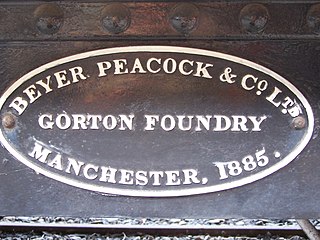
Beyer, Peacock and Company was an English general engineering company and railway locomotive manufacturer with a factory in Openshaw, Manchester. Charles Beyer, Richard Peacock and Henry Robertson founded the company in 1854. The company closed its railway operations in the early 1960s. It retained its stock market listing until 1976, when it was bought and absorbed by National Chemical Industries of Saudi Arabia.
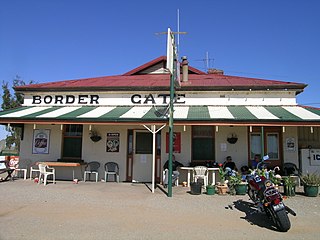
Cockburn is a town and locality in the east of the Australian state of South Australia immediately adjacent to the border with New South Wales near Broken Hill. It was established because the New South Wales government refused to allow locomotives of the South Australian Railways to operate in its jurisdiction, requiring locomotives to be changed at the town for 84 years until 1970, when the route was converted from 1067 mm to 1435 mm standard gauge.

Southern & Silverton Rail was an Australian rail operator founded in 1886 as the Silverton Tramway Company. The company operated the 1067 mm Silverton Tramway, conveying silver-lead-zinc concentrates 58 kilometres from Broken Hill to the South Australian border. In 1970, its main line was bypassed by the newly standardised, government-funded line from Broken Hill to Port Pirie. It then diversified to operating hook-and-pull services and in the mid-1990s rebranded to Silverton Rail. In 2006, it was purchased by South Spur Rail Services and rebranded again as Southern & Silverton Rail, before both entities were sold to Coote Industrial. In June 2010 it was sold to Qube Logistics and absorbed into that brand.

The Broken Hill railway line, extending 801 kilometres from Orange, New South Wales to Broken Hill, is now part of the transcontinental rail corridor from Sydney to Perth.

The National Railway Museum, Port Adelaide, South Australia is the largest railway museum in Australia. More than 100 major exhibits, mainly from the South Australian Railways (SAR) and Commonwealth Railways and their successor, Australian National, are displayed at its 3.5 hectares site. A very large archival collection of photographs of those railways and records created by them is also managed by the museum. The museum is operated with a large number of volunteers.
The Berrima railway line is a partly closed private railway line in New South Wales, Australia. It was a short branch from the Main South line to serve the Berrima Colliery.

The Silverton Tramway was a 58-kilometre-long 1,067 mm railway line running from Cockburn on the South Australian state border to Broken Hill in New South Wales. Operating between 1888 and 1970, it served the mines in Broken Hill, and formed the link between the 1,435 mmstandard gauge New South Wales Government Railways and the narrow gauge South Australian Railways lines. It was owned and operated by the Silverton Tramway Company (STC).
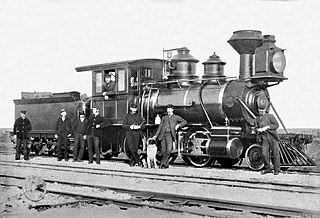
The South Australian Railways X class was a class of 2-6-0 steam locomotives operated by the South Australian Railways on its narrow-gauge lines.
Tarrawingee is a locality and a ghost town in the Far West region of New South Wales, some 60 kilometres (37 mi) north of the town of Broken Hill. The town was established in 1889 to exploit a deposit of limestone needed as flux for the smelters at Broken Hill. The township grew to accommodate 400 people and facilities included a post office, two pubs, a police station, a court house and a school. In 1898, smelting moved to Port Pirie and the limestone quarry closed. Today only the stone foundations of a few buildings remain.
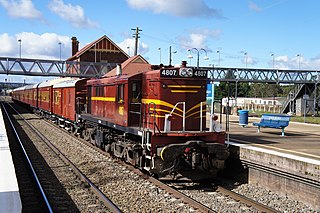
The Alco DL531, also known as the RSD8 is a model of railway locomotive manufactured and operated in various countries.
The Silverton Tramway 48s class are a class of diesel locomotives built by AE Goodwin, Auburn for the Silverton Tramway in 1960–1961. The State Rail Authority 48 class and South Australian Railways 830 class are of a very similar design.

The South Australian Railways Y class was a class of narrow gauge steam locomotives operated by the South Australian Railways.
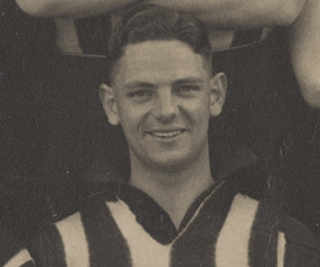
Lewis Edgar Roberts was an Australian rules footballer, railwayman and businessman, best known as a prominent player for the Port Adelaide Football Club in the South Australian National Football League (SANFL).

Sulphide Street railway station was the terminus of the Silverton Tramway in New South Wales, Australia. It served the city of Broken Hill.

The Silverton Tramway Y class was a class of 2-6-0 and 2-6-2T steam locomotives of the Silverton Tramway Company, operating between Broken Hill, New South Wales, and the border of South Australia.
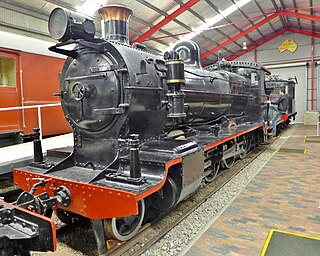
The Silverton Tramway A class was a class of 4-6-0 steam locomotives operated by the Silverton Tramway Company.
James Smith Reid generally referred to as "J. S. Reid" and familiarly as "Smith", was an Australian newspaper owner, editor and businessman.

The Cangai Copper Mine was operated by Grafton Copper Mining Company Ltd at Cangai in northern New South Wales from 1904 to 1917.















